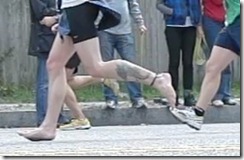 I was recently interviewed about my book, Tread Lightly, by Samantha Chang of examiner.com. One of the topics that she asked about was barefoot running – specifically, she wanted me to discuss some of the pros and cons of running barefoot.
I was recently interviewed about my book, Tread Lightly, by Samantha Chang of examiner.com. One of the topics that she asked about was barefoot running – specifically, she wanted me to discuss some of the pros and cons of running barefoot.
I’m admittedly not much of a barefoot runner (pretty tough to do for about 4-5 months of the year up here in New Hampshire!), but have done it and enjoyed it on several occasions. Chapter 3 of Tread Lightly deals extensively with the topic of barefoot running, and it appears multiple times elsewhere in the book.
I wanted to share my answer to Samantha’s question here, and point you to the interview should you want to read more (lots of the questions focused on the health benefits of running in general, which I was happy about since the sport has really changed my life – just passed my five-year running anniversary!).
You can click here to read the entire interview on examiner.com, and my answer to the barefoot running question is below – it pretty well summarizes my current thoughts on the topic.
As always, if you have any thoughts of your own about the pros and cons of barefoot running, feel free to share in the comments section below!
SC: I read the chapter on barefoot running with particular interest because the practice has a small but growing (and avid) following. You wisely noted that barefoot running may not be totally practical in today’s modern world (e.g., stray hypodermic needle, impact of hard surfaces), but also suggest that many runners could benefit by incorporating some barefoot running into their routines. Can you elaborate on this?
PL: There are some very real risks associated with barefoot running, and stepping on something is one of them. However, I think the hypodermic needle issue gets overplayed a bit.
Running barefoot forces you to be really aware of where you place your feet, and as long as you use your eyes to scan the ground, the chances of stepping on something nasty are pretty low. I’m by no means a regular barefoot runner, but I’ve tried it a few times and have found it to be enjoyable under the right conditions.
The bigger risk for someone wanting to try barefoot running is that running without shoes forces you to change your form. For one thing, it will really work your calf muscles, and they can be very sore at the start. Second, the skin on your feet takes time to condition, and blistering is common among new barefoot runners. Third, the bones and connective tissues in your feet need time to strengthen to handle the different kinds of stress placed on them when shoes are removed. If you do too much too soon in bare feet it is possible to suffer injuries like stress fractures of the foot bones.
The benefit of barefoot running is that it removes all interference between your foot and the ground, and is thus a great way to feel your form. Your foot is a highly sensory structure, and it will tell you when you are doing something wrong. Though your form will adapt when you take off your shoes, the type of adaptations seen may not be the same in all people.
Some people will continue to land on their heels when they switch to barefoot (I’ve videotaped many runners doing this!), at least for a time, but most will shorten their stride, which can be of benefit in reducing forces applied to joints like the knees and hips. Furthermore, since people run differently when barefoot, it will work your leg and foot muscles in a different way. Some will get stronger as a result (e.g., your calf muscles).
However, if you go exclusively barefoot, other groups of muscles may de-condition somewhat (e.g., the muscles on the front of your shin). Different footwear (or lack thereof) will work your muscles in different ways.
I’ll add that barefoot does not need to be an all-or-nothing thing. Even doing small amounts of barefoot running can be of benefit – in fact, it’s a common practice among track and cross-country teams to do a bit of barefoot running in their training.
If you do decide to try it, it’s important to be very gradual and careful. Starting out with as little as a minute of barefoot running at a time is a wise approach. Listen to your body, and build from there. If anything feels painful, then ease back. It’s ok to mix barefoot in very slowly while running in regular shoes.
And if barefoot isn’t for you, trying out a very minimal shoe for occasional form or strengthening work is another approach. It won’t be the same as true barefoot, but it may be more practical for a lot of people. Once you get started by giving it a try, you can decide how big a part of your running repertoire it will become.














What a thoughtful and useful response! I agree with everything you said. (And I am a committed barefoot runner, who has run 20+ races barefoot each year for the past two years, and will likely run far more than that this year.)
I would hasten to add, however, that just because barefoot running works well for some of us, it would be unwise for any runner to shed the shoes if he or she are running now without injury. If you are lucky enough to be able to run without injury, then DON’T CHANGE A THING!!! You are very lucky, and should not mess with what works.
Thanks for the comment Ken, good to hear that from a guy who runs barefoot as much as you do!
Pete